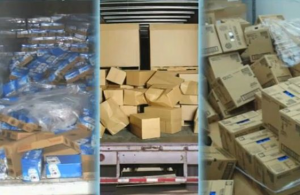*Updated 12-18-17*
Stretch wrap failure can be very costly.
Your stretch wrap keeps breaking, and it's not wrapping your pallets or products correctly. I bet these questions are going through your head. Why does my stretch wrap break? What causes stretch film to break? Why does the film keep breaking. Pallets aren't staying together with stretch wrap.
Knowing what causes the most typical failures can help you avoid the consequences.
 Stretch wrap failure can be caused by a number of issues with your film. Let us help you stop damage before it starts.
Stretch wrap failure can be caused by a number of issues with your film. Let us help you stop damage before it starts.Why do failures occur?
- Lack of understanding of containment force
- Lack of established standards in stretch wrap application
- Film flaws
What is containment force?
Containment force or force to load is the amount of force the film exerts on the load to maintain its integrity. This is extremely important when down-gauging or when converting to a different film. This measurement will show the customer that the load integrity is just as good, or better than it was before.
- Pre-stretch: Normally a fixed value affected by the equipment’s gear ratio. This is the amount of stretch achieved in the equipment’s pre-stretch rollers.
- Force-to-Load stretch: The amount film stretches as it is applied to the load. This figure may deviate from the equipment’s pre-stretch. Factors such as equipment settings and film composition affect the “on pallet” stretch.
Why do you need standards in application?
Without a standard set regarding application of stretch wrap, especially hand-stretch, loss of strength is inevitable. Total film revolutions must be consistent to ensure even distribution of force; consistent pre-stretch ensures appropriate application of all engineered strength in stretch wrap. All of these aspects ensure consistent, high quality containment, minimizing the potential for damage during transit.
What are the most common film flaws to keep a look out for?
- An ultimate break is a straight line break with pointed edges. The break occurs when the film has been pre-stretched beyond its limits.
- A gel is a V shaped break in the film caused by resin imperfection or some other manufacturing problem.
- Bad edges are nicks or flaws in the edge of the film that can cause a diagonal tear or break through the film.
So, what can you do to help prevent stretch wrap failure?
When it comes to determining how to prevent stretch wrap failure, it is critical to have a partner who understands the science behind the plastic. The right partner can help you rite-gauge. Rite-gauging is the application of the correct film, thickness, overlap, revolutions, and force-to-load, ensuring equal containment forces at the top, middle, and bottom of the pallet. It sets a containment standard that is measurable, repeatable, and cost/pallet effective. all while reducing risk and variance.
Our knowledgeable Account Managers and Packaging Engineers can help you rite-gauge your stretch wrap appropriately. And we have years of experience in stretch wrap that we want to share, so we've created the Ultimate Stretch Wrap Guide to get you on the right path to the rite gauge.


